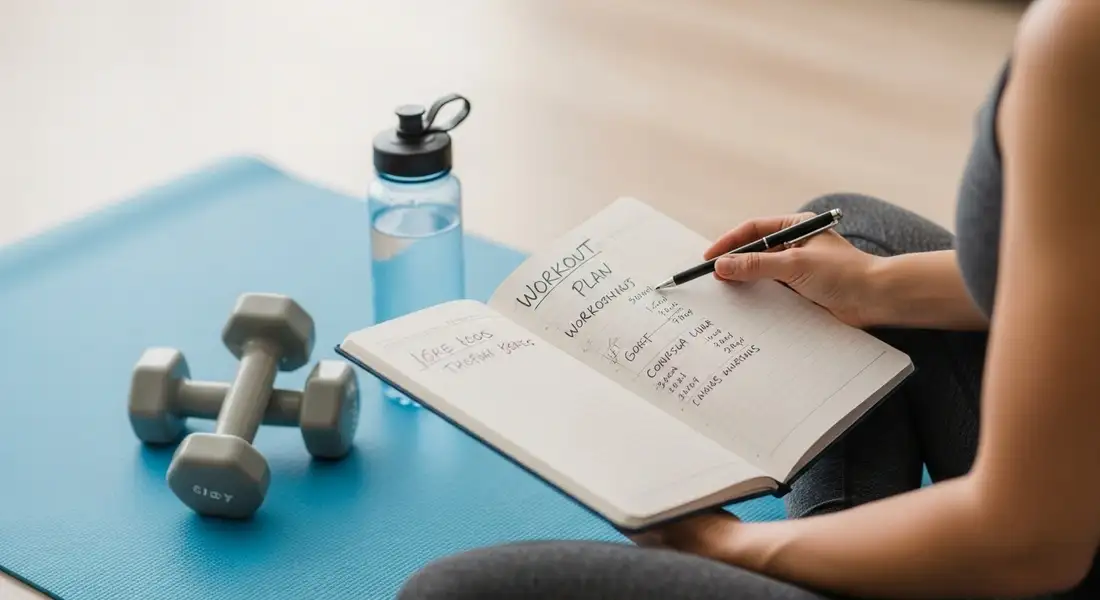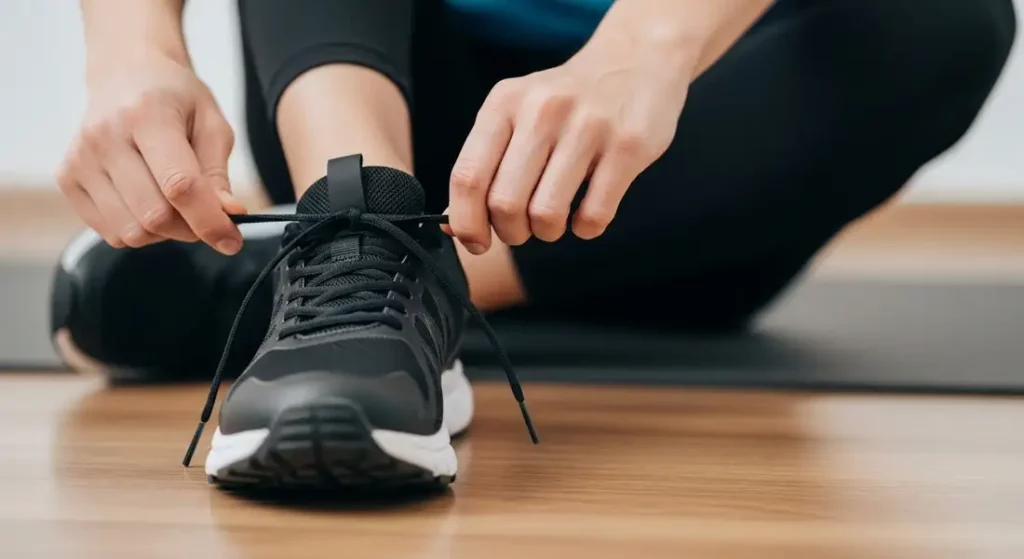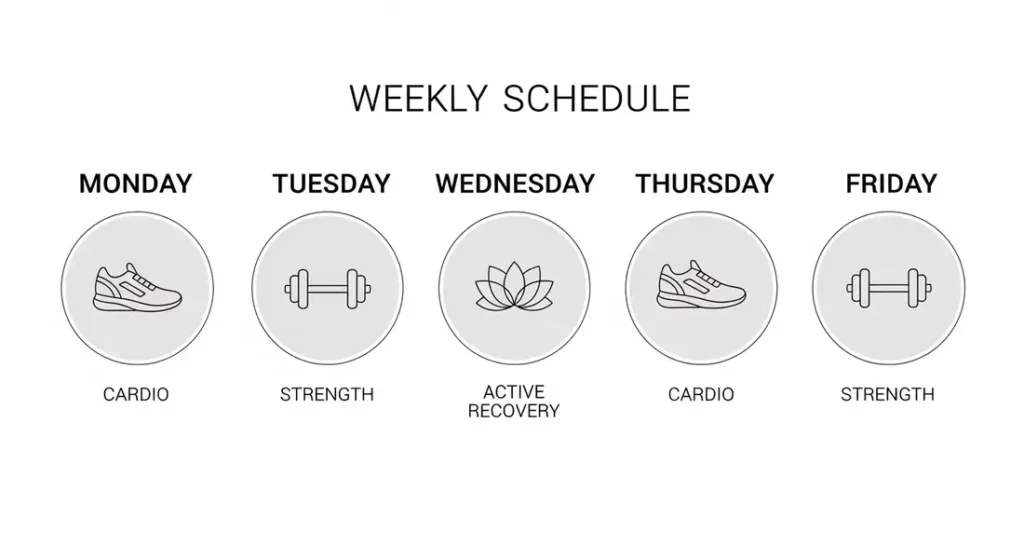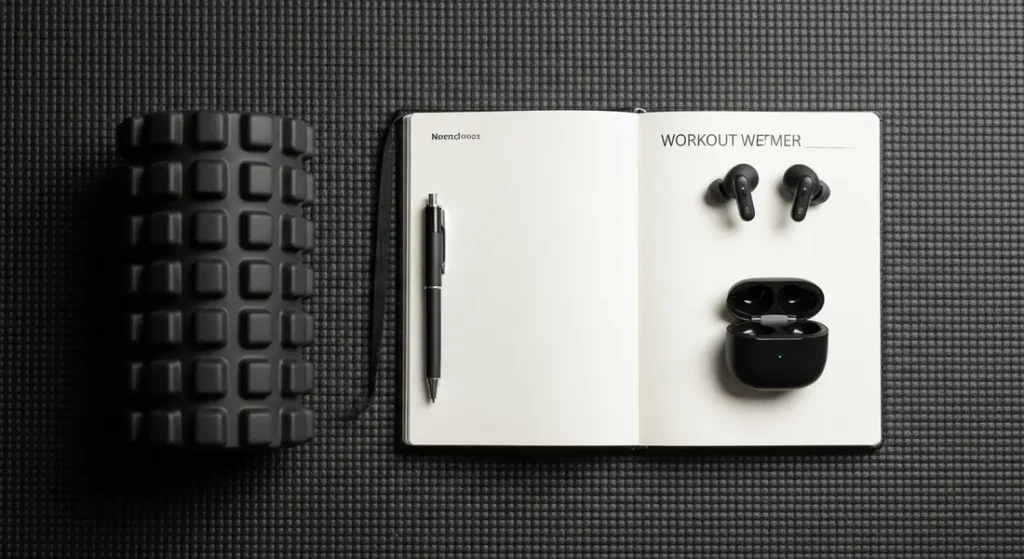You’ve learned why cardio is essential, how strength training builds a fat-burning engine, and the nutritional principles to fuel your journey.
Now, it’s time to put that knowledge into action.

A goal without a plan is just a wish, and this guide provides your road map.
As the next step in our Beginner’s Guide to Weight Loss at Home, this workout plan is your coach-designed schedule for the first four weeks.
It’s built to be simple, effective, and sustainable, focusing on consistency over intensity to help you build a fitness habit that lasts.
Before You Begin – The 3 Rules of Success

To get the most out of this plan and stay injury-free, commit these three rules to heart.
- Always Warm-Up and Cool-Down: A 5-minute warm-up (like light jogging in place, arm circles, and leg swings) prepares your muscles for exercise. A 5-minute cool-down (with gentle stretching) helps with recovery. This is non-negotiable.
- Form Over Everything: It is far better to do 8 perfect squats than 15 sloppy ones. Bad form leads to injury. If you’re unsure, watch videos of the exercises and use a mirror to check your technique.
- Listen to Your Body: “No pain, no gain” is a myth. You should feel your muscles working, but you should never feel sharp, stabbing pain. Muscle soreness is normal; joint pain is not. Rest when you need to.
Your 4-Week Beginner Workout Plan
This plan is designed around a 5-day-a-week schedule, with two dedicated rest days.
We will alternate between Cardio and Strength days to allow for muscle recovery.

The Exercises:
- Strength Day A: Bodyweight Squats, Push-ups (on knees or against a wall), Planks, Glute Bridges.
- Strength Day B: Alternating Lunges, Dumbbell Rows (using a dumbbell or a heavy household object), Lying Leg Raises, Bird-Dog.
- Cardio: Choose any machine or activity you enjoy (brisk walking, treadmill, elliptical, stationary bike).
- Active Recovery: Gentle stretching, a slow walk, or foam rolling.
How to Read the Plan:
- Sets and Reps: “3 sets of 8-12 reps” means you perform the exercise for 8 to 12 repetitions, rest for 60 seconds, and then repeat that cycle two more times. For planks, hold the position for the time specified.
Week 1: Building the Foundation
Goal: Learn the movements and establish a routine. Focus on form.
| Day | Activity | Workout Details |
| Monday | Cardio | 20 minutes at a steady, comfortable pace |
| Tuesday | Strength Day A | 2 sets of 8-10 reps. Plank: 2 sets of 20-second holds. |
| Wednesday | Active Recovery | 15-20 minutes of full-body stretching. |
| Thursday | Cardio | 20 minutes at a steady, comfortable pace |
| Friday | Strength Day B | 2 sets of 8-10 reps (per side for lunges/rows). |
| Saturday | Active Recovery | Go for a 30-minute walk. |
| Sunday | Rest | Complete Rest |
Week 2: Building Consistency
Goal: Increase duration slightly and continue to master form.
| Day | Activity | Workout Details |
| Monday | Cardio | 25 minutes at a steady pace. |
| Tuesday | Strength Day A | 3 sets of 8-10 reps. Plank: 3 sets of 20-second holds. |
| Wednesday | Active Recovery | 15-20 minutes of full-body stretching. |
| Thursday | Cardio | 25 minutes. Try adding a small challenge (e.g., slight incline). |
| Friday | Strength Day B | 3 sets of 8-10 reps (per side). |
| Saturday | Active Recovery | Go for a 30-45 minute walk. |
| Sunday | Rest | Complete Rest |
Week 3: Increasing the Challenge
Goal: Push yourself a little harder. Increase reps or hold time.
| Day | Activity | Workout Details |
| Monday | Cardio | 30 minutes at a steady pace. |
| Tuesday | Strength Day A | 3 sets of 10-12 reps. Plank: 3 sets of 30-second holds. |
| Wednesday | Active Recovery | 15-20 minutes of full-body stretching. |
| Thursday | Cardio | 30 minutes. Try 5 minutes of higher intensity in the middle. |
| Friday | Strength Day B | 3 sets of 10-12 reps (per side). |
| Saturday | Active Recovery | Go for a 45-minute walk or do a beginner yoga video. |
| Sunday | Rest | Complete Rest |
Week 4: Solidifying the Habit
Goal: Feel confident in the routine and your ability to complete the workouts.
| Day | Activity | Workout Details |
| Monday | Cardio | 30 minutes. Push your pace slightly for the whole time. |
| Tuesday | Strength Day A | 3 sets of 12 reps. Plank: 3 sets of 30-45 second holds. |
| Wednesday | Active Recovery | 15-20 minutes of full-body stretching. |
| Thursday | Cardio | 30 minutes. Try a new type of cardio if available. |
| Friday | Strength Day B | 3 sets of 12 reps (per side). |
| Saturday | Active Recovery | Go for a 45-minute walk. |
| Sunday | Rest | Complete Rest |
What to Do When… (Troubleshooting Your First Month)
Even with the best plan, you’ll run into challenges. Here’s how to handle the most common ones without getting discouraged.
Problem: “I’m really sore after my strength workouts. Should I skip the next one?”
Feeling sore a day or two after a new workout is completely normal. It’s called Delayed Onset Muscle Soreness (DOMS), and it’s a sign your muscles are adapting.
- The Solution: Don’t stop moving! The best cure for soreness is light activity. On your active recovery days, a gentle walk or some stretching will increase blood flow to the muscles and help reduce stiffness. For your next workout, do a thorough warm-up and consider starting with a lighter version of the exercises. The soreness will lessen as your body gets used to the routine.
Problem: “I had a crazy day and missed my workout. Have I ruined my week?”
Absolutely not. The biggest mistake is letting one missed day turn into a missed week.
- The Solution: Use the “Never Miss Twice” rule. Life happens. You might miss a Monday. Forgive yourself, and then do whatever it takes to make sure you get Tuesday’s workout in. The goal is not perfection; it’s consistency. Jump right back on the plan at the next scheduled day.
Coach’s Toolkit – Gear for Better Workouts & Recovery

A few simple tools can dramatically improve your comfort, consistency, and recovery.
- A Foam Roller: This is your personal massage therapist. A foam roller is an invaluable tool for working out the muscle soreness we just talked about. Rolling out your quads, hamstrings, and back after a workout can help speed up recovery and improve flexibility.
- A Workout Journal: The secret to long-term results is making sure you’re always progressing. A simple notebook is one of the most powerful tools you can own. Track the exercises, weights, sets, and reps you do for each workout. Your goal each week is to beat your logbook by doing just one more rep or lifting a little heavier.
- Good Wireless Earbuds: Music is a proven performance enhancer and motivator. A pair of sweat-proof wireless earbuds can make your workouts more enjoyable, helping you push through tough sets and making cardio sessions fly by.
What Happens After Week 4? The Power of Progressive Overload
Congratulations! You’ve built a fantastic habit.
The key now is progressive overload—the principle of making your workouts slightly more challenging over time to keep seeing results. Here’s how:
- Increase the Weight: If you’re using dumbbells and 12 reps feel easy, it’s time to move to the next weight up.
- Increase the Reps/Sets: Add another set to your strength days.
- Increase the Intensity: Push your pace or add resistance on your cardio days.
- Try New Exercises: Swap out one of the exercises for a new one to challenge your body in a different way.
This plan is your launchpad, not your final destination.
Return to the Beginner’s Guide to Weight Loss at Home for more foundational knowledge.
What part of this plan are you most excited to start? Let us know in the comments below!
